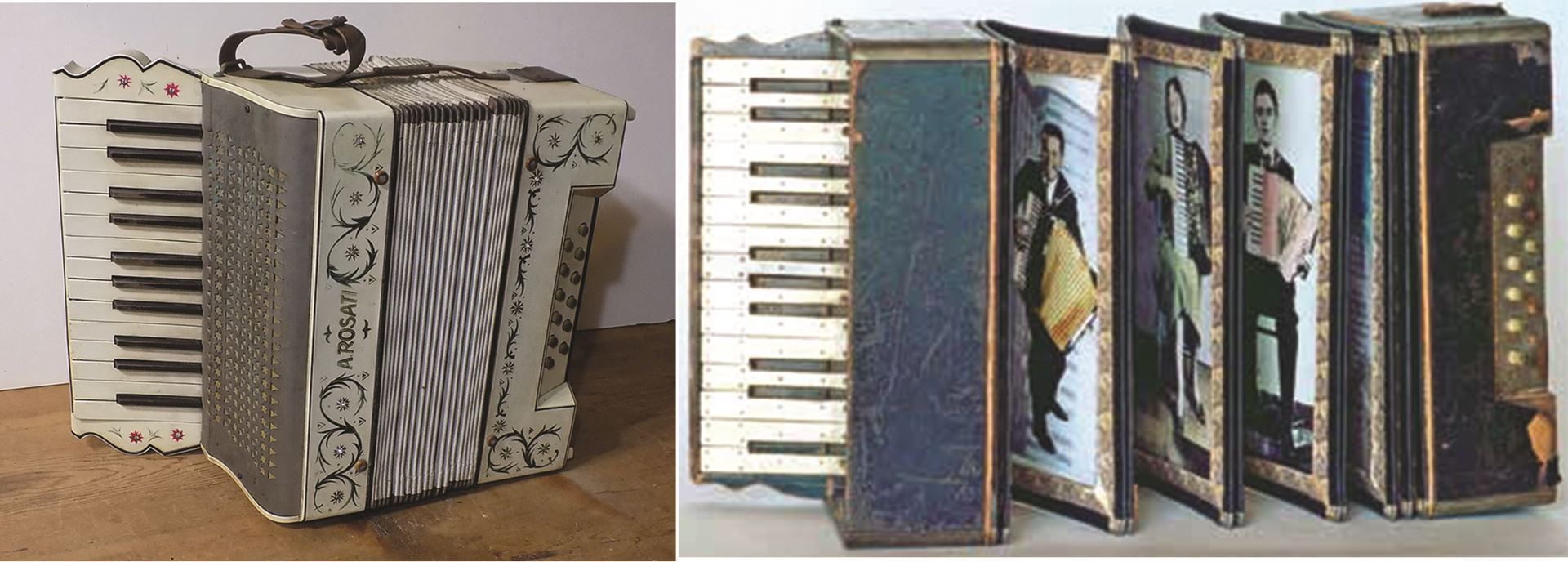In 2000 I had the idea to make an accordion book. Not your regular accordion book, this one would be made from a real accordion, with the keyboards as covers, and the bellows would be cut along the vertical ends, so that when it was pulled open it would look like a real accordion book! I play the accordion and couldn’t pass up the opportunity presented by the visual pun, but the real purpose for making the book was to address a point of confusion among book artists: whether a folded paper book should be called an accordion book or a concertina book. From playing both musical instruments, I knew that an accordion is rectangular, and a concertina is hexagonal. I made my first real accordion book in tandem with a book made out of a concertina to physically explain why, unless a book is hexagonal in shape, the correct term is accordion book.

Peter and Donna Thomas, The Real Accordion Book, 2001

Peter and Donna Thomas, The Real Concertina Book, 2001
Following is my short history of the accordion book, explaining how format came to be generally know called an accordion book.
The word accordion was first used early in the nineteenth century to describe a small, portable, box-shaped musical instrument. It had a button keyboard on the right-hand side for playing melody notes, another button keyboard on the left-hand side for playing bass and chordal accompaniment, and folded paper bellows connecting the two keyboards together. Metal reeds, attached to the keyboards, were mounted inside the bellows. When buttons were pushed while the bellows were being expanded and contracted, air was forced past the metal reeds, causing them to vibrate and produce sound. The term accordion book borrows from the musical instrument. It describes any book having a folded, rather than sewn, text block, where the pages are pleated – folded back and forth in a manner similar to the bellows of an accordion, rather than being folded as a map – and are viewed by expanding the book like an accordion.
The invention of the accordion was inspired by an ancient Chinese, mouth-blown musical instrument called the sheng. The sheng was first displayed in Western Europe in the late seventeenth century. It used free reeds in resonator pipes to create musical sounds, and this concept led to the invention of several different harmonica-like instruments. The success of those inventions encouraged organ-makers to try a new direction in their efforts to create low-cost pump organs for small-town churches; this, in turn, led to the creation of the accordion. Most historians credit Cyrill Demian, of Vienna, as the inventor of the first accordion. In 1829, he patented an instrument where the left hand operated a button keyboard and the right hand moved the bellows. He called his invention an Akkordion. The word is based on akkord, in this case referring to musical harmony, with the suffix –ion, being thought to derive from the word clarion, a sort of medieval trumpet.
In some countries the accordion’s name is a variation on the word harmonica (for example, harmonika in Bosnia and harmonikka in Finland). In Italy it is called a fisarmonica, said to be derived from physharmonica, the name given by Anton Haeckl to his 1818 invention that combined harmonica and bellows to make an instrument resembling the modern hand-held harmonium. Other countries have unique names; for example, in Sweden it is called a dragspel, where drag means pull and spel means play. The accordion also has nicknames: in English it is sometimes called a squeezebox, and in Germany it is sometimes called a schifferklavier (sailor's piano). Sometimes the accordion is mistakenly called a concertina, or vice versa, but the words are not interchangeable. Though the concertina is also in the aerophone family, it is typically smaller, shaped as a hexagon rather than as a square or a rectangle, and its buttons are organized differently.
Accordion books, like musical accordions, can also have different names. For example, German binders call accordion books Leporellos. In German dictionaries, Leporello is defined as “a fan of folded paper.” In the 1787 opera Don Giovanni, with music by Wolfgang Mozart and an Italian libretto by Lorenzo Da Ponte, Don Giovanni’s servant is named Leporello. In Act 1, Scene 2, Leporello sings what is now commonly known as the “catalogue aria.” In this scene, Leporello takes a book from his bag and pulls out a long folding strip of paper that lists all of Don Giovanni’s romantic conquests. (I find it interesting to speculate which came first; was the servant named after the book structure or vice versa?) The term concertina book, for me a misnomer, is used by some English speakers to describe an accordion book. Perhaps this originated in England, where the concertina was more popular than the accordion.
While the history of the accordion began in the seventeenth century, the history of the accordion book is actually much older, and that will be the subject of the next post.
Peter and Donna Thomas are book artists who make editioned and one-of-a-kind books. They make the paper, print, illustrate, and bind their books, combining the precision of the fine press aesthetic with the creativity found in contemporary artists' books. In 2021 The Legacy Press published Peter and Donna Thomas: Bibliography, 1974–2020.

